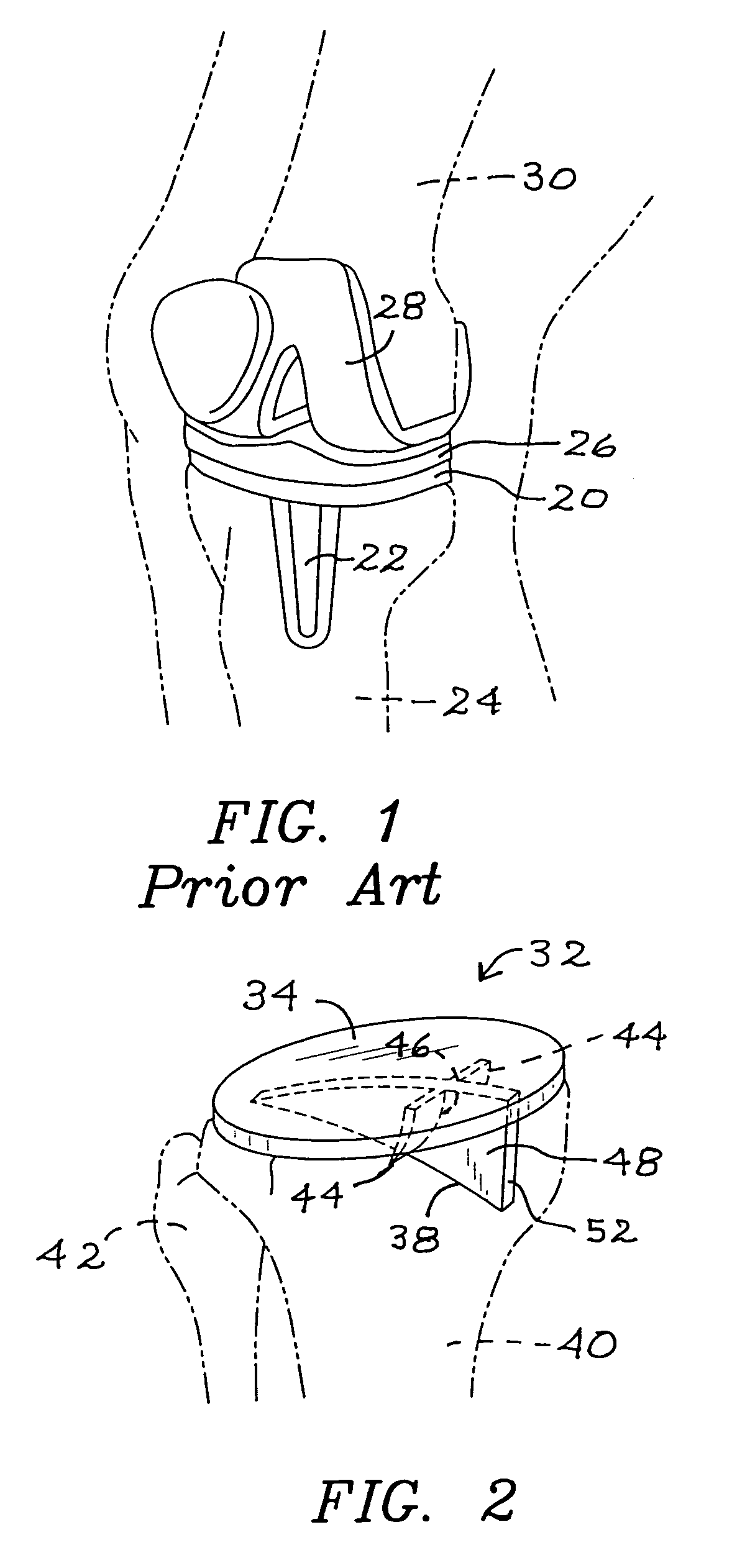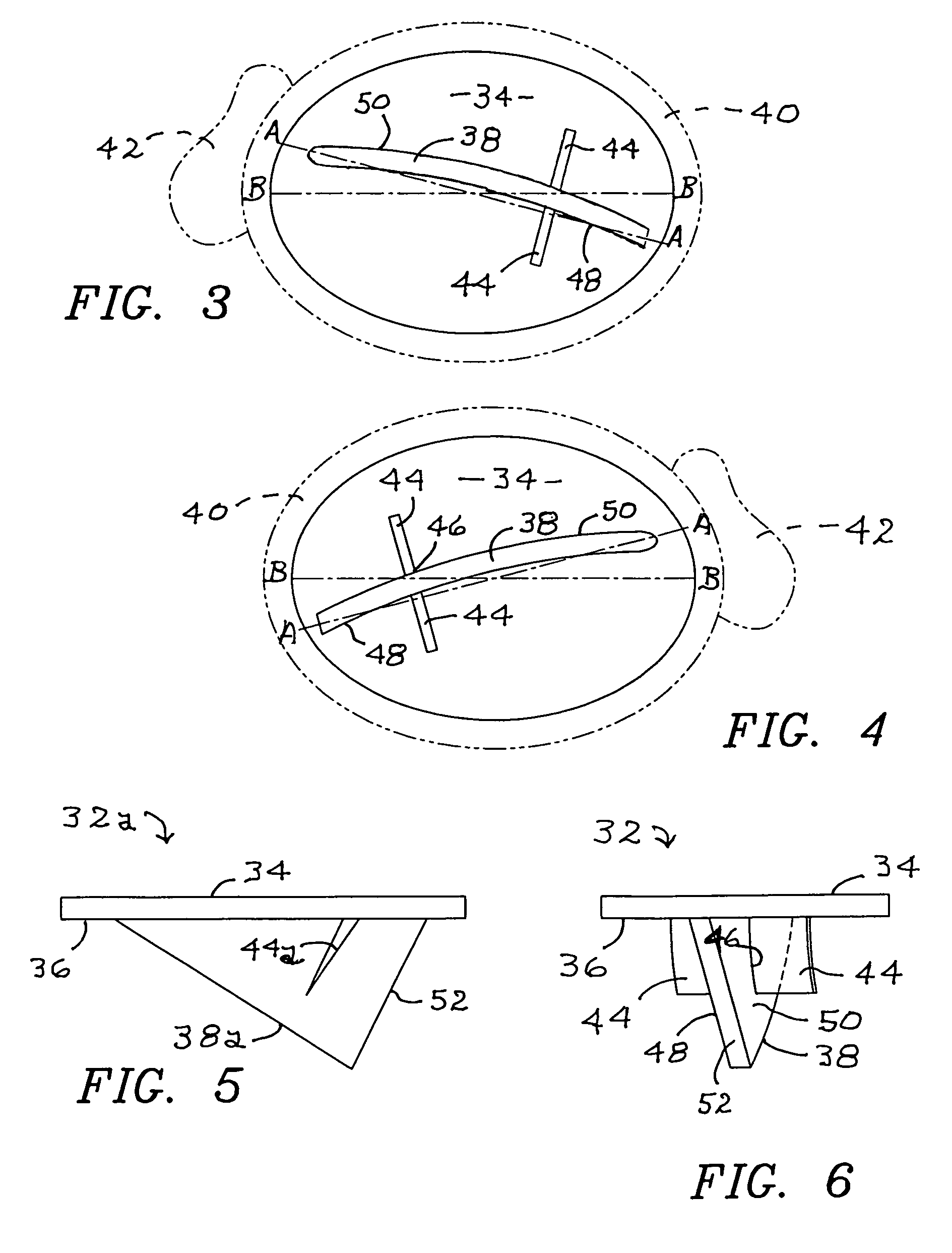Tibial tray for total knee arthroplasty
a technology for arthroplasty and tibia, which is applied in the field of improved tibial trays, can solve the problems of increased difficulty, increased cost of modular devices, and difficulty, and achieve the effects of enhancing the ease with which excess cement may be removed, ensuring stability, and providing strength and rotational stability
- Summary
- Abstract
- Description
- Claims
- Application Information
AI Technical Summary
Benefits of technology
Problems solved by technology
Method used
Image
Examples
first embodiment
[0026]Embodiments of the improved tibial tray of this invention are shown in the remaining figures, and attention is first invited to the view of FIG. 2 wherein the improved tibial tray is generally indicated as 32. Tibial tray 32 includes a top surface 34 and a bottom surface 36. Integrally formed on bottom surface 36 and extending downwardly therefrom is asymmetric keel 38. Shown in phantom in the view of FIG. 2 is an anterior view of the patient's tibia 40 and fibula 42. Also shown in the view of FIG. 2 are a pair of opposed fins 44. Fins 44 are integrally formed on bottom surface 36 and extend downwardly, each including a keel edge 46 that is integral with a corresponding first side 48 and second side 50 of asymmetric keel 38. The view of FIG. 3 is a superior plan illustration of placement of tibial tray 32, as shown in the view of FIG. 2. The view of FIG. 4 illustrates placement of the improved tibial tray on the patient's other leg.
[0027]As can be seen in the views of FIGS. 2-...
second embodiment
[0030]The view of FIG. 5 depicts a second embodiment for the improved tibial tray of this invention, generally indicated as 32a. In this embodiment for tibial tray 32a, fins 44a are not curved, and asymmetric keel 38a is not curved. Furthermore, the embodiment for tibial tray 32a may include a single fin 44a, and the use of a single fin may be employed in all embodiments of this invention.
third embodiment
[0031]Turning to the view of FIG. 8, a third embodiment for the improved tibial tray is generally indicated as 32b. As can be clearly seen in the view of FIG. 8, asymmetric keel 38b is of a curved configuration, rather than angular. Of course, asymmetric keel 38b still includes an edge 52b that extends downwardly from bottom surface 36 to a maximum depth within tibia 40. In this embodiment of improved tibial tray 32b, asymmetric keel 38b is preferably curved as is keel 38, but may be straight as described with regard to keel 38a.
[0032]The view of FIG. 7 is provided to illustrate preparation of tibia 40 for insertion and attachment of the improved tibial tray of this invention. A trial tray 54 is attached to tibia 40 as by pins 56, then a chisel 58 is repeatedly struck by mallet 60 to form a void 62 for receiving the asymmetric keel of the improved tibial tray. It is, of course, to be understood that chisel 58 would be dimensioned and configured to provide a void 62 corresponding to...
PUM
 Login to View More
Login to View More Abstract
Description
Claims
Application Information
 Login to View More
Login to View More - R&D
- Intellectual Property
- Life Sciences
- Materials
- Tech Scout
- Unparalleled Data Quality
- Higher Quality Content
- 60% Fewer Hallucinations
Browse by: Latest US Patents, China's latest patents, Technical Efficacy Thesaurus, Application Domain, Technology Topic, Popular Technical Reports.
© 2025 PatSnap. All rights reserved.Legal|Privacy policy|Modern Slavery Act Transparency Statement|Sitemap|About US| Contact US: help@patsnap.com



